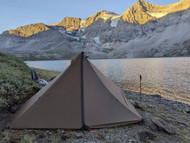Customer Adventure Series - An Expedition in the Canadian Wilderness -
Posted by Corey Trick on 28th Sep 2023
Our group of seven embarked with plans to tackle the Southesk Lake Loop trail in Jasper National Park, which was to cover 70 miles over 6 days. Most of this trek would take place on trails that have not been maintained for nearly 20 years. To compound the difficulty, the area experienced heavy wind storms in June of this year, which toppled many trees over the maintained trails. Many within our group had completed similar trips, but this was my first major backcountry expedition. Despite the daunting challenge, I was excited to push myself and put my gear to a true test in the elements it was designed to withstand.
Everything started out well for the trip, weather was exceptional, and we made our first two camps at Medicine Tent and Cairne Pass in good time. We shared camp the first night with a Canadian hiker who was doing a 120 mile point to point trip and he gave us valuable information about the trail up until we would set out on our own over Dean’s Pass. He mentioned only going a half kilometer an hour through some of the sections we would encounter on our second day, but our group actually traversed these areas well.
However, that changed as we crossed the pass, the GPS marked trail we had been using as guide, became quite inaccurate, and we found ourselves adding 4-6 miles a day. Combine that with trail finding through all manners of terrain and our days became slugfests. We would pick up the old trail from time to time as animals were using it as a game trail, but it was almost completely overgrown, often through very boggy terrain. The forests were covered in mossy undergrowth, fluffy, root infested, undergrowth. You never knew if your step would be solid or sink to your knee. For me, it was an adventure and likened it to a hunting trip, but I could tell it was draining others. Those that had been on these group trips before all agreed this was the hardest trip yet. Despite the hard hiking, Glacier Pass and the lake were unworldly. One of those, “how does this exist?” type of areas.
We found a great, lakeshore campsite and built up the pad with rocks and moss because of the shore angle. Pitched the Seek Outside Cimarron with a combination of stakes and rocks and just enjoyed the views. I am very thankful for picking Austin and Ryan's brains about different details for pitching the Cimarron on varying terrain, because I was able to get the shelter set quickly and properly nearly every time using stakes, branches, roots or rocks. This ability came in crucial on our last day. Having the Cimarron Full Nest available was also critical with bugs still being an issue with all the water in the area.
Longer days caught up to us, when on the last night we decided to set camp at another site and opt for a longer final day. That night we were hit with a storm that dumped a foot and half of snow at elevation and 3 inches of rain throughout the valley. Unfortunately for us, all that water flowed towards us and through the river we did not cross the previous night. Overnight, it went from a knee deep, clear river to a raging, chest high, murky, torrential river. We attempted a crossing, but a man was swept under and with temps dropping, we are now looking at a hypothermia situation. We decided as a group to push further along the river to potentially find another crossing point and actually found the marking for our exit trail, but we could not get across the river. We tried using logs as a handrail, but the river just swept them away. We were stuck on a banded portion of the river and the water just kept rising. With the river turning the whole area into a giant bog, no sign of the weather relenting and the inability to get dry, we opted to find shelter.
During this time we got the one man who fell in dry clothes, but with that weather, it didn't stay dry long. We found shelter just inside the tree line, with a large clearing in case we needed to call SOS. With freezing temps incoming and forecast for the same tomorrow morning, the severity of the situation was becoming real.
In a moment, the Cimarron was out of my pack and pitched to the best of my ability on a fairly steep slant, and all seven huddled inside. Even after cooking the last of our food and some coffee, my friend's situation was deteriorating as well as others with compromised gear. After assessing the situation, we decided to contact SOS, via Garmin InReach. With the weather, we were unsure if they could make it, but after two hours of waiting, we heard the sweet, unnatural sounds of helicopter blades chopping through the valley. Landing right in the clearing by camp, with poor weather conditions, they decided the best option was to ferry us three-quarters of a mile to a warden cabin to dry out and warm up. Three-quarters of a mile was all we needed, but with a raging river and wet clothes and sleeping bags, mother nature kicked us in the teeth.
I am grateful for the emergency responders, their determination to get us to a safe location and the Cimarron for buying us time for them to arrive. There are so many lessons to glean from this trip, it solidified trust in my gear choices, built confidence in my ability to think under pressure and stretched my physical capabilities.
…